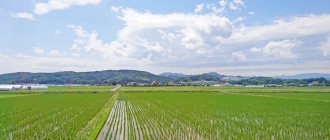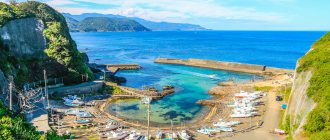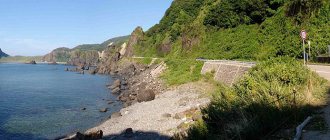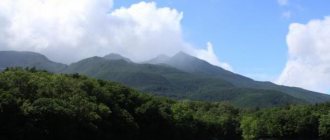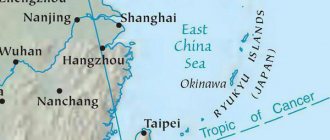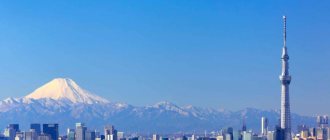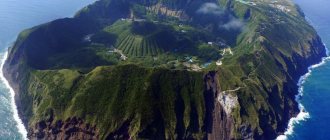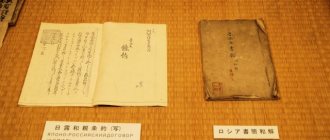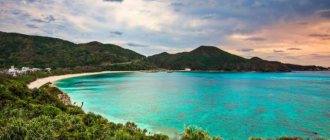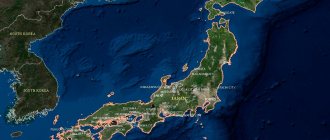Major islands of Japan
Honshu
. The largest island of the Japanese archipelago, previously also known by such names as Hondo and Nippon, accounting for 60% of the area of the entire country. The length of the island is 1300 kilometers, the width ranges from 50 to 230 kilometers. About 100,000,000 people live permanently on Honshu. Major cities such as Tokyo, Osaka, Hiroshima, Kyoto, Yokohama are located here. The symbol of Japan is Mount Fuji, also located on Honshu.
Hokkaido
. Also known in the past as Ezo, Ieddo, Iesso, Matsumae. The second largest island of Japan, separated from Honshu by the Sangar Strait. In total, about 5.5 million people live here; famous cities include Sapporo, Chitose, and Wakkanai. Since the climate on this island is noticeably colder than in the rest of the country, among the Japanese themselves, Hokkaido is considered a “harsh server”. Despite the fact that geographically most of the settlements are located south of Paris, the climate is very different from European.
Kyushu
. The third largest island of Japan, according to some sources, considered the birthplace of Japanese civilization. Currently, there are such large cities as Fukuoka, Nagasaki, Hirado, Oita, Kagoshima and Kumamoto, the total population of Kyushu is about 12 million people. In the northern part of Kyushu, industry is highly developed, especially chemical and metalworking, and in the south - agriculture and cattle breeding.
Shikoku
. The fourth largest Japanese island, home to about 4 million people. Most of the major cities and population are concentrated in the northern part of Shikoku. The most famous cities include Matsuyama, Tokushima, Kochi, Takamatsu. Shikoku is known throughout the world for its 88 pilgrimage temples, which are associated with the activities of the legendary Buddhist monk Kukai. Heavy engineering and shipbuilding are developed in the northern part of the island, and agriculture is developed in the southern part. However, despite this, Shikoku makes a very small contribution to the country's economy - no more than 3%. In addition, the problem of population aging is more pressing here than anywhere else in Japan. Because young people are actively leaving for Tokyo, Osaka and other large cities of the country.
Dear and beloved grandson of Kim Il Sung
But it is not only the territorial dispute between China and Japan and the United States that threatens peace in this region. Pyongyang added fuel to the fire and aggravated the situation. On the night of March 25, 2021, the DPRK launched two ballistic missiles that fell outside the Japanese economic zone in the Pacific Ocean. The next day, North Korea launched short-range cruise missiles. According to Western experts, this was an attempt by North Korean leader Kim Jong-un to ease the pressure of the Biden administration’s sanctions policy. But the consequences of such a not very attractive gesture can be very sad. It is well known that the technical level of North Korean missiles and the accuracy of their hits leave much to be desired. If even one of them goes off course and falls on South Korea or Japan, a full-scale war will not be avoided. But in addition to short- and medium-range missiles, the DPRK has intercontinental ballistic missiles. The newest of them is Hwasong-16.
Reference
Hwasong-16 is transported using a special ten-axle heavy-duty wheeled chassis. Its length is 25-26 meters, diameter - from 2.5 to 2.9 meters. The mass ranges from 100 to 150 tons (depending on whether all stages are solid fuel or liquid). Flight range is 13 thousand kilometers. The maximum altitude of the trajectory is 4,500 kilometers. The weight of the warhead is 2,500 kilograms. It is assumed that the Hwasong-16 is equipped with a multiple warhead capable of carrying up to five individually targetable warheads. The missile is capable of reaching any point in the United States.
Another ballistic missile designed for submarines, which Pyongyang has already dubbed “the most powerful weapon in the world,” is the Pukguksong-5 (“Pukguksong-5” or “Polar Star-5”). The new rocket is longer than its predecessor. Western experts believe that it is capable of hitting a target at a distance of up to 15 thousand km. Pukguksong-5 is armed with a multiple independently targetable warhead. In addition, it is equipped with a complex to overcome enemy missile defense systems. According to experts, the combat characteristics of Pukguksong-5 make it possible to strike any targets located on the North American continent.
© commons.wikimedia.org/Winluxhuman
Hwasong-16 intercontinental ballistic missile.
Southern Islands
The Southern Islands of Japan usually include the Ryukyu Islands, located to the southwest of the main part of the country, the Bonin Islands, located in the Pacific Ocean, at a distance of 1000 km from Tokyo, and the most remote island of Minamitori.
Bonin Islands
is a group of 41 islands located between the Mariana Islands and Japan south of Tokyo. The total area does not exceed 104 square kilometers, the total population is about 2,500 people. There is a Japanese naval base on the southern island of Yojima.
Ryukyu Islands
is a group of 98 islands stretching 1,200 kilometers in the East China Sea from Kyushu to Taiwan and having a total area of 4,700 square meters. km. Currently, only 47 of them have a permanent population. The total number of inhabitants is 1.6 million people, 90% of whom live on the largest island - Okinawa. The most developed sectors of the economy are agriculture, fishing and tourism.
Minamitori
- the easternmost island of all that belonged to Japan. Minamitori has an area of 1.2 square kilometers and has no permanent population. Despite this, the island is of great strategic importance to the country, as it allows Japan to claim 428,875 km² in the surrounding waters.
And the dispute over the deserted archipelago has lasted for more than a hundred years.
The arrival of the Biden administration in the White House is characterized by a further increase in anti-Russian and anti-Chinese sentiment. Not a day goes by without another White House official making another false accusation against the two countries. In his interview with CNN on March 28, 2021, US Secretary of State Antony Blinken said that the US will engage in dialogue with China from a position of strength. Earlier, the head of the Pentagon, General Lloyd, called his Japanese counterpart Nobuo Kishi and said that the United States would provide Japan with all possible assistance in the dispute with the PRC over the territorial ownership of the Senkaku Islands (Chinese name for Diaoyu).
It must be said that the dispute between Beijing and Tokyo over this deserted archipelago in the East China Sea has been going on for more than a hundred years. In addition to China and Japan, the authorities of Taiwan lay claim to the islands.
© Photo by the author Senkaku Archipelago (location).
To confirm the Chinese identity of the Senkaku Islands, Beijing presents Japanese maps of 1783 and 1785, on which the archipelago is designated as part of Chinese territory. In response, Tokyo states that in 1895, as a result of the victorious war over the Manchu Qing Empire, the Senkaku (Diaoyu) archipelago and the island of Taiwan were ceded to the Japanese Empire under the Treaty of Shimonoseki.
Background
The Senkaku Archipelago includes five small islands and three small ones with a total area of 6.3 square meters. km. In 1932, the Japanese government sold four islands to the Japanese Kurihara family, leaving one as government property. After the end of World War II, under pressure from Washington, Tokyo renounced its rights to the island of Taiwan, but the Senkaku Islands, due to their important strategic location, remained under the control of the US Army, and only in 1972 were they transferred to Japan. Tokyo considers the archipelago part of Okinawa Prefecture.
The situation around the Senkaku Islands worsened in the 70s. 20th century after large reserves of natural gas were discovered in the archipelago area, and the adjacent waters turned out to be rich in fisheries. Owning islands has become profitable, since the adjacent economic zone allows you to make significant profits and control international trade routes.
© atoapiwag.ru
Senkaku Islands (close-up).
In 1978, Japan and China agreed to freeze the issue of ownership of the Senkaku Islands, and in 1992 they decided to postpone the territorial dispute “to the discretion of future generations.” In 2011, China began developing a gas field located on the shelf near the border with Japan. Tokyo protested because... considered the deposit to be Japanese, a small part of which is located in China.
In September 2012, the Japanese government bought three islands from the Japanese Kurihara family for $26 million with the goal of subsequently selling gas production licenses to Japanese companies.
Mass demonstrations were held in more than 100 Chinese cities to protest against Tokyo's policies. Japanese-owned restaurants, shops and businesses were destroyed. The Chinese navy has begun regular patrols of the disputed archipelago. From time to time, Chinese ships enter the coastal waters of the Senkakus, thus demonstrating who historically belongs to the islands.
© RIA Novosti
From time to time, Chinese ships enter the coastal waters of the Senkakus, thus demonstrating who historically belongs to the islands.
Taiwan did not stand aside either. In September 2012, more than 50 fishing vessels attempted to storm the archipelago. Accompanied by six patrol ships, they headed towards the largest island, but their path was soon blocked by ships of the Japanese coast guard. Using water cannons, the Japanese tried to stop the Taiwanese fishing schooners and patrol ships, to which the latter responded with powerful jets of sea water. Only thanks to their numerical superiority were the Japanese able to defend the disputed archipelago.
In November 2013, the Chinese Ministry of Defense created an identification zone in the East China Sea, including the Senkaku Islands. Now, in order to avoid being shot down by Chinese air defense systems, aircraft from all countries of the world must request permission from the Chinese authorities to fly over the archipelago.
According to The Japan Times, in 2015, the Japanese Foreign Ministry found a Chinese map from 1969, on which the islands are named in Japanese - Senkaku, which allowed Tokyo to talk about their Japanese origin. Despite this, on March 6, 2021, the Chinese Foreign Ministry spokesman stated that the Diaoyu (Senkaku) Islands belong to China regardless of what the Japanese government says and does.
© kaskus.co.id
Senkaku Islands (distance to neighboring territories and islands).

